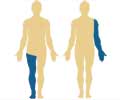Researchers at Children's Memorial Research Center have, for the first time, identified Apolipoprotein E (APOE), a gene associated with heightened risk for Alzheimer's disease
Researchers at Children's Memorial Research Center have, for the first time, identified Apolipoprotein E (APOE), a gene associated with heightened risk for Alzheimer's disease in adults, can also increase the likelihood that brain-injured newborns would develop cerebral palsy.
This is the first identification of a gene that increases susceptibility to cerebral palsy. Results of the study, published in the February issue of the journal Pediatrics, may enable early identification of children who are at risk for poor neuro-developmental outcome after brain injury as newborns and thus target those children for early therapeutic intervention.The lead scientist on the study was Mark S. Wainwright, M.D., Ph.D., assistant professor of pediatrics (neurology) and molecular pharmacology and biological chemistry at Northwestern University's Feinberg School of Medicine and the Children's Memorial Research Center. Wainwright is also a researcher in the Center for Drug Discovery and Chemical Biology at Feinberg.
Wainwright and his laboratory group compared APOE genotypes in 209 children with cerebral palsy and a matched control group of children in good health. They found that children who carry the E4 or the E2 form (or allele) of the APOE gene are not only more likely to develop cerebral palsy but also to have more severe neurologic impairment following perinatal brain injury, just as adults who carry the E4 form of the APOE gene may be more susceptible to developing Alzheimer's disease and have worse outcome after brain injury, including stroke and head injury.
Overall findings from the study showed that carrying the E4 allele was associated with greater than a threefold-elevated risk for cerebral palsy. The risk was higher for children with quadriplegia/triplegia and was associated with more severe motor impairment in this group.
Cerebral palsy affects two in every 1,000 school-aged children in the United States, has an annual economic toll on society estimated at $5 billion and is the most costly of the clinically significant birth defects in the United States.
Cerebral palsy encompasses a diverse group of disorders characterized by non-progressive impairment of motor function resulting from injury to the developing brain. Cerebral palsy is often associated with impaired intellectual function, sensory deficits, behavioral disorders and seizures. In the majority of cases, a specific cause for cerebral palsy cannot be identified.
Advertisement
"People who carry the E4 allele may not be able to recover as effectively from a brain injury, making these newborns at greater risk for developing cerebral palsy," he said.
Advertisement
Source-Eurekalert
SRI











